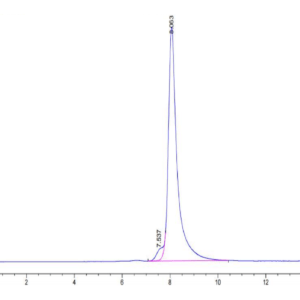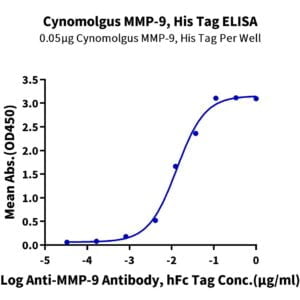| Weight | 1 lbs |
|---|---|
| Dimensions | 9 × 5 × 2 in |
| accession | Q9NQS3 |
| express system | HEK293 |
| product tag | C-hFc |
| purity | > 95% as determined by Tris-Bis PAGE;> 95% as determined by HPLC |
| background | The Nectin family has at least four members (Nectin-1‑4), all of which show alternate splicing, a transmembrane (TM) region (except for Nectin-1 gamma), and three extracellular Ig-domains. Nectins are highly homologous to the human receptor for poliovirus, and as such, have been alternatively-named poliovirus receptor-related proteins. They do not, however, appear to bind poliovirus. Nectin-3 (also named PRR3, CD113, and PVRL3) is an 83 kDa, type I TM glycoprotein. Its precursor is 549 amino acids (aa) in length. It contains an extended signal sequence of 57 aa, an extracellular domain (ECD) of 347 aa, a transmembrane segment of 21 aa (aa 405-425), and a cytoplasmic region of 124 amino acids. |
| molecular weight | The protein has a predicted MW of 63.63 kDa. Due to glycosylation, the protein migrates to 80-110 kDa based on Tris-Bis PAGE result. |
| available size | 100 µg, 500 µg |
| endotoxin | Less than 1EU per μg by the LAL method. |
Human Nectin-3/CD113 Protein 2116
$240.00 – $800.00
Summary
- Expression: HEK293
- Functional: Yes (ELISA)
- Amino Acid Range: Gly58-Asp400
Human Nectin-3/CD113 Protein 2116
| protein |
|---|
| Size and concentration 100, 500µg and liquid |
| Form Liquid |
| Storage Instructions Valid for 12 months from date of receipt when stored at -80°C. Recommend to aliquot the protein into smaller quantities for optimal storage. Please minimize freeze-thaw cycles. |
| Storage buffer Shipped with dry ice. |
| Purity > 95% as determined by Tris-Bis PAGE |
| target relevance |
|---|
| The Nectin family has at least four members (Nectin-1-4), all of which show alternate splicing, a transmembrane (TM) region (except for Nectin-1 gamma), and three extracellular Ig-domains. Nectins are highly homologous to the human receptor for poliovirus, and as such, have been alternatively-named poliovirus receptor-related proteins. They do not, however, appear to bind poliovirus. Nectin-3 (also named PRR3, CD113, and PVRL3) is an 83 kDa, type I TM glycoprotein. Its precursor is 549 amino acids (aa) in length. It contains an extended signal sequence of 57 aa, an extracellular domain (ECD) of 347 aa, a transmembrane segment of 21 aa (aa 405-425), and a cytoplasmic region of 124 amino acids. |
| Protein names Nectin-3 (CDw113) (Nectin cell adhesion molecule 3) (Poliovirus receptor-related protein 3) (CD antigen CD113) |
| Gene names NECTIN3,NECTIN3 PRR3 PVRL3 |
| Protein family Nectin family |
| Mass 9606Da |
| Function Plays a role in cell-cell adhesion through heterophilic trans-interactions with nectin-like proteins or nectins, such as trans-interaction with NECTIN2 at Sertoli-spermatid junctions. Trans-interaction with PVR induces activation of CDC42 and RAC small G proteins through common signaling molecules such as SRC and RAP1. Also involved in the formation of cell-cell junctions, including adherens junctions and synapses. Induces endocytosis-mediated down-regulation of PVR from the cell surface, resulting in reduction of cell movement and proliferation. Plays a role in the morphology of the ciliary body. |
| Subellular location Cell membrane ; Single-pass membrane protein. Postsynaptic cell membrane . |
| Tissues Predominantly expressed in testis and placenta as well as in many cell lines, including epithelial cell lines. |
| Structure Cis- and trans-homodimer. Can form trans-heterodimers with NECTIN1, NECTIN2, PVR, IGSF4B/Necl-1 and with IGSF4. Interaction between NECTIN1 and NECTIN3 on the pre- and postsynaptic sites, respectively, initiates the formation of puncta adherentia junctions between axons and dendrites. Interacts (via Cytoplasmic domain) with AFDN, providing a connection with the actin cytoskeleton. Binds with low affinity to TIGIT.; (Microbial infection) Interacts with C.difficile toxin TcdB, suggesting that it may contribute to TcdB toxin entry into cells (PubMed:26038560). It was however shown that NECTIN3/PVRL3 does not act as a major receptor for TcdB (PubMed:27680706). |
| Target Relevance information above includes information from UniProt accession: Q9NQS3 |
| The UniProt Consortium |
Data
Publications
Publications
| pmid | title | authors | citation |
|---|---|---|---|
| We haven't added any publications to our database yet. | |||
Protocols
| relevant to this product |
|---|
Documents
| # | ||
|---|---|---|
| Please enter your product and batch number here to retrieve product datasheet, SDS, and QC information. | ||

















